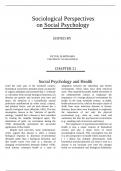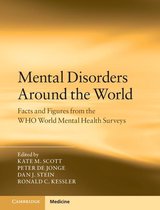Sociological Perspectives
on Social Psychology
EDITED BY
VICTOR. M MITHAMO
UNIVERSITY OF MAASTRICH
CHAPTER 21
Social Psychology and Health
Until the early part of the twentieth century, adaptation between the individual and his/her
biomedical researchers attended nearly exclusively environment. These ideas have deep historical
to organic pathogens and assumed that: ( l ) disease roots. They inspired the public health movement of
is a deviation from normal biological functions; (2) the midnineteenth century to emphasize the
diseases are generic and invariant over time and importance of a benign physical environment for
space; (3) medicine is a scientifically neutral health. In the early twentieth century, as public
profession uninfluenced by wider social, cultural, health advances led to a shift in the major causes of
and political forces; and (4) each disease has a death from acute infectious diseases to chronic
specific biological cause (Mischler 1981). This last diseases, these ideas were broadened to emphasize
assumption, known as the "doctrine of specific the importance of not only the physical
etiology.' implied that a disease is best controlled environment (e.g., clean air, water, food, and
by treating the culpable biological agent. The sanitation) but also the psychosocial environment
elimination of polio via vaccination during the (e.g., smoking, lack of exercise, and stress).
1950s dramatically epitomized the successful The importance of psychosocial influences on
application of this model. health is now a major concern of biomedical
Despite such successes, some contemporary science and also a major focus of social
critics argued that disease is often a normal psychological research. This convergence has led
biological response to abnormal environmental to a new perspective on health which assumes that:
demands rather than a biological deviation, and ( l ) illness has multiple determinants, both
that health varies over time as a function of biomedical and psychosocial; (2) what is seen as a
changing environmental demands (Dubos 1959). disease is not invariant over time but changes
Such notions construed health as a state of based on sociocultural and biological definitions;
,and (3) the medical profession is a social
institution that shapes its members' views based on
broad sociocultural considerations that go beyond
scientific concerns.
It is impossible to encompass in a single
chapter the full range of research that has evolved
from this perspective; our review is necessarily
selective. In the first half of the chapter, we discuss
research on the psychosocial determinants of
illness, and in the second half we discuss research
on the psychosocial determinants of illness
definition and response. In each section we present
an historical overview, discuss recent
developments, and propose future directions.
PSYCHOSOCIAL DETERMINANTS
OF ILLNESS
Although the organism-environment adaptation
perspective operates at both microscopic and
macroscopic levels, the two sometimes have been
estranged by disciplinary boundaries. The more
microscopic perspective, characteristic pf psycho-
, CHAPTER 21 and Health
physiologists and psychological social psychologists, has where many stressors are chronic and
focused on how proximal environmental stimuli and inescapable. In the face of these modern stresses,
contexts (e.g., stress and social support) affect individuals' GAS can lead to what Selye called ' 'diseases of
behavior, mood, and physiology. The more macroscopic adaptation," such as hypertension, heart disease,
approach, characteristic of many sociologists, ulcers, and arthritis.
demographers, epi- demiologists, and sociological social Although Selye's model provides a useful
psychologists, has focused on the broader distribution of framework for understanding how psychosocial
health and illness in populations by such characteristics as stresses promote physical illness, it does not
age, race, gender, and geographic location. This explain how the subjective sense of stress itself
macroscopic approach also considers historical and is generated. Subsequently, social psychologists
contextual influences on health, providing insights not developed the framework known as the stress
apparent from an individual perspective. The decline in and adaptation model. This framework suggests
smoking in the United States is a good illustration. The that characteristics of situations and individuals
long-term effects of smoking intervention programs at the combine to create perceptions of stress or threat,
individual level have been modest. Yet smoking has which ideally elicit responses that reduce stress
declined markedly and steadily in the United States over and protect health. Failure to do so results in ill
the past quarter century due to broader contextual changes health via mechanisms such as those originally
—restriction of smoking in public places, increases in explored by Cannon and Selye or those
costs, and a changing set of societal norms, attitudes, and identified by more contemporary
values regarding smoking induced by political and mass biopsychosocial researchers. Whether situations
media institutions working through intermediate levels of are experienced as stressful and how persons
social organization. An important direction for future respond to them is now seen as a function of
development would integrate the more microscopic and both preexisting personal dispositions and other
macroscopic traditions in an effort to illuminate how stress aspects of the situation. sometimes referred to as
and adaptation are structured by broad social forces and moderating, buffering. or vulnerability factors
how microsocial phenomena affect psychophysiological (see House 198 1; Lazarus and Folkman 1984:
processes to produce observed patterns of health and McGrath 1970; for variations on this
illness. framework).
Since the mid- 1970s. the stress and
adaptation framework has stimulated major
Emergence of the Stress and Adaptation developments in the study of the perception of
Perspective and response to potentially stressful situations in
During the middle of the twentieth century, social psychology and related areas of medical
physiologists Walter Cannon (1932) and Hans Selye sociology and health psychology. The evidence
(1956) described a syndrome of physiological linking stress and other psychosocial factors to
responses (including adrenocortical secretions and health is growing steadily and. although as of
related neuroendocrine activation, increased gastric yet not definitive, is made quite plausible by the
secretions, and higher heart rate and blood pressure) convergences of both laboratory studies of
to a wide range of environmental stressors or animals and humans and nonexperimental
challenges, including infectious agents, heat, cold, research on broader human populations, recently
physical pressure and restraint, and social augmented by intervention studies.
psychological threat. Selye called this syndrome the The initial breakthroughs in research on
"general adaptation syndrome" (GAS). psychosocial determinants of illness occurred as
Social Psvchologv 549 the psychosocial stress and adaptation
perspective was just emerging. Initiated by
physicians rather than social scientists, such
According to Selye, GAS originally evolved as
work has been superseded by more
an adaptive response to physical stressors but
psychosocially sophisticated and empirically
has become maladaptive in modern society,






